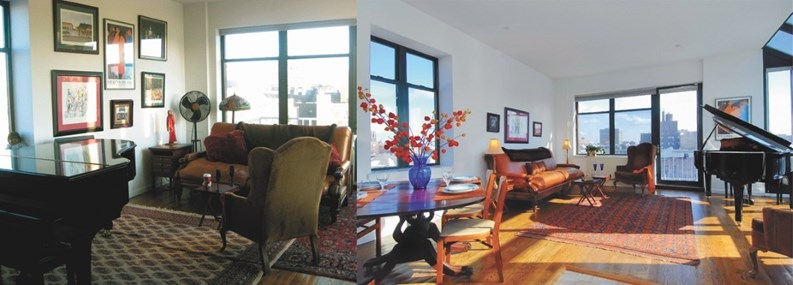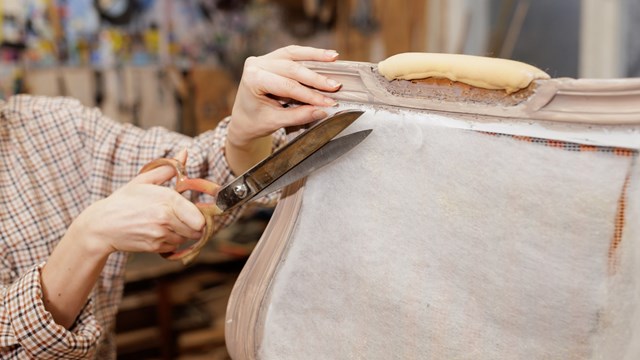In today’s tough real estate market, people are searching for every advantage they can find when it comes time to sell their property. They’ll search out the best agent they can find. Or place ads in the highest circulation magazines. They’ll lower the price to outpace the competition. But often, people will neglect the most important piece of the whole puzzle: the space itself.
Properly preparing a home for sale can be the difference between whether it sells quickly or instead lingers on the market for months at a time. “Ninety five percent of homes staged sell in 65 days or less versus non-staged homes at 175 days or longer,” says Barb Schwarz, who created the term ‘staging’ more than 30 years ago and is today the owner of the California-based Staged Homes. Staging can help “sell a home more quickly and for more money”—both things that are music to a seller’s ears.
Creating the Ideal Space
Preparing a home to sell means more than just making the space look good. It’s about making the space palatable and appealing to fresh eyes, helping people visualize themselves living there. That’s one way that staging differs from decorating. “Decorating is about personalizing a space,” Schwarz says. “Staging is about de-personalizing a place.”
Schwarz relies on the three C’s of staging to make a place more appealing: clean, clutter-free and color. Cleanliness is absolutely imperative when it comes to selling a home. “People may think a property is clean but they have to see it with other people’s eyes,” Schwarz says. “You have to get it Q-Tip clean.” That includes everything from baseboards to light switches, right on up to the bigger things that people rarely consider like windows.
Tied in with cleaning is clutter, something that can sabotage even the most attractive living area. It’s one of the top mistakes home sellers make, says Nairn Friemann, a certified staging professional and owner of Ingenuity and Pizzazz, Inc., based in New York. “When we ask brokers what went wrong [with a space], they say that people just have too much stuff,” Friemann says. “People get distracted. You want the place to be as bright and spacious as possible. Buyers will base their judgment on how they feel inside the space.” And even if the apartment is the most well-appointed, well-decorated space in the building with million dollar paintings on the wall, “you have to remind people that they’re selling the space, not an art gallery.”
Schwarz agrees. “Clutter eats equity,” she says. “People don’t realize how much stuff they have. The home has to be clutter free.”
“It may seem obvious, but having a clean house is very critical,” says Barbara Brock, of A Proper Place, a Manhattan-based home stager, decorator and professional organizer. “Buyers will be comfortable exploring every nook and cranny when they notice that your house is spotlessly clean. They will also sense that the house has been lovingly cared for. Clean every inch of space and every item in it. Or, hire professionals to start the process.”
“When people come to see a house, they don’t spend a lot of time in there,” says Darren Brand, owner of Designed to Sell in North Pickering, Ontario. “If it doesn’t make a good first impression, that’s a problem. You really have to put your best foot forward.”
Being clutter-free, however, does not mean stripping the place bare. “Put too much away and it feels empty,” Schwarz says. “You have to strike the right balance.”
Being empty, in fact, can slow a sale. “Vacant condos and co-ops just aren’t moving,” Friemann says. “If it’s just a big empty box—people can’t visualize what it should look like.”
The Color Code
Once everything is cleaned and cleared of unnecessary accessories, it’s time to delve into painting. “I’ve been in houses where the family’s lived for 40 years and it’s not been painted in 25,” says Brand. “You can leave it that way and hope for the best, but even when the market was really hot, properties that weren’t maintained weren’t selling.”
Color is also important, says Brand. “Color elicits such a strong emotional response for so many people. It’s the least expensive, highest return on investment you can make.”
Friemann agrees. “More than 60 percent of a first impression is based on color,” she says. “Nothing refreshes and energizes a space as quickly and cheaply as new paint.”
Just throwing a fresh coat up on the walls, though, will not do the trick. Of all the aesthetic considerations made during the staging process, perhaps none is more important than color choice. “When you’re marketing a home, it’s important that your color choices appeal to a broad spectrum of people,” Friemann says.
The true test of a color’s value is to see how it works against the other elements in the room. “It has to be a color that anyone can put furniture against,” Brand says. “It has to complement the fixed elements in the room like flooring or tile.”
For example, Brand says, “You need to be careful of stagers who say red is a good color for a dining room. It is, but it’s not a good color for selling a dining room.”
Appearances matter to get maximum return on investment, says Brock. “Choose warm, neutral colors for paint, flooring or wall coverings. Fairly neutral decor sells the best as most people cannot visualize past dark green walls or rust shag carpeting. Many also want a ready-to-move in house and do not want to spend the time, energy or money painting or replacing materials after they move in.”
That’s not to say that bold colors do not have their place in the equation—they do, but most likely as accents or accessories. “Color on the walls makes walls appear smaller,” Schwarz says. “But you don’t want it to be boring, so you want color for the accessories like bath towels, bed linens or area rugs.”
Other things to watch out for are oversized pieces of furniture that can make a space look cramped and out of scale. It’s also important to make sure that a space is being used the way it was meant to be used. That means if a homeowner’s been using the dining room as an office space, it’s time to turn it back into a dining room.
Lighting also can be an issue. “You need to maximize natural light,” Friemann says, underscoring the fact that most people come to look at a property after work when it’s dark so it’s important to add additional lighting wherever possible. And don’t forget the small details. “We’re selling lifestyles when we sell real estate,” Friemann adds. “It can all come down to linens on the bed. Make a minor investment in fresh linens, fresh flowers and greenery. Make people will feel welcomed.”
How the Process Works
In general, most stagers will give clients two options when it comes to the services they can provide. For anywhere from $250 to $600, a staging professional will provide a home consultation, which means he or she will do a detailed walk-through of your living space and create a proposal on what can and should be done to improve the space. Schwarz’s plans run from 30 to 50 pages and offer clients a slew of options, allowing them to take the ideas and run. Both Friemann and Brand also provide consultations. “We do a room-by-room estimate and make very specific recommendations,” Friemann says.
For bigger fixes—perhaps where lighting is concerned or repair work has to be done—the stager should also be able to provide a list of bonded and licensed contractors.
To actually stage a home—take pictures, make notes, provide a proposal and do the work costs on average $1,800, says Schwarz. “We bring in a six- to eight-person team and can do a 3,200-square-foot-home in one day.” This will include arranging furniture, adding linens and flowers and providing each and every final detail that will help a space achieve its true aesthetic potential.
There might be an additional charge for furniture or other prop rental, but for the most part, stagers will try to work with whatever is in the house. Say Schwarz, who trains and certifies stagers, “we show our students how to stage a place with no money, using people’s own furniture and possessions. This is not about selling people extra furniture and drapes. We’re all about selling the space and helping the owner sell it for more.”
A Growing Trend
In New York, more and more realtors are turning to stagers for help in moving a property, says Friemann. “We’re working on brokers’ teams now,” she says. “They’re bringing us in immediately when they get a property. We’re also getting a lot of brokers who haven’t staged in the past. If your competition is staging and you’re not, then you’re losing that competitiveness.”
Realtors are teaming up with stagers, too, because they can provide the kind of top-quality photo options that attract buyers.
“Sellers who make an effort to stage their homes are getting substantially more money at closing than those who simply put their home on the market ‘as is,’ says Brock. “With Internet marketing being the first place 75 percent of people look, a photograph can indeed be an asset and added advantage to getting someone in to see the property.”
As the housing market continues to stay soft, those inquiries should only rise. “The public is just now waking up to staging,” Schwarz says. “Only ten percent of sellers stage their houses now but that’s up from three percent.”
The growing demand means more and more individuals are offering staging services. It’s important to check their credentials, Schwarz says, and hire Accredited Staging Professionals who will have liability insurance, legal training and the documentation necessary to protect homeowners and provide them with a certain standard of service.
There is no doubt that today more than ever co-op and condo sellers need an edge and staging can provide it. For a condo owner, Friemann says, there are “huge carrying costs— maintenance, insurance, the mortgage. Staging can help move these properties faster.”
A home is the most important investment a person will make in their lifetime. What better incentive is there than that?
Liz Lent is a freelance writer and a frequent contributor to The Cooperator.







Leave a Comment